Pour être un bon entrepreneur ou un bon décideur de nos jours, il faut se munir de bons outils. Le monde bouge tellement vite que si vous ne voulez pas vous faire devancer par vos concurrents, le mieux est de prendre les devants. Heureusement, la technologie évolue dans ce sens et permet de créer des logiciels performants comme le logiciel ERP gratuit ou payant. Ils vous seront d’une grande utilité pour travailler plus vite et pour faire des analyses et des prévisions sur les activités de votre entreprise. Mais voilà, il y en a tellement ! Lequel choisir ? C’est une excellente question dans la mesure où il n’est pas très sage de changer de logiciel ERP tout le temps. Faire une migration peut prendre du temps. Vous devez également tenir compte du temps de prise en main et des frais que cela va engendrer. Pour beaucoup d’ERP gratuits ou payants par exemple, même en Open Source, les supports et les formations sont payants.
Besoin d’un ERP gratuit ou payant facile à utiliser, opérationnel, en qui vous pouvez avoir confiance et qui n’est pas cher? Top 12 des meilleurs ERP
L’offre Dolisim, un excellent ERP open source qui vous appartient
Aujourd’hui, les entreprises optent majoritairement pour les ERP hébergés dans le Cloud, et ça se comprend vu les innombrables avantages que cela apporte :
- Pas de serveur à acheter
- Pas d’installation à faire
- Pas de maintenance à faire
- Vous pouvez travailler d’où que vous le souhaitez
- Vous pouvez travailler à plusieurs en même temps
- Les sauvegardes sont automatiques
- Le coût est bien plus maîtrisé
- etc.
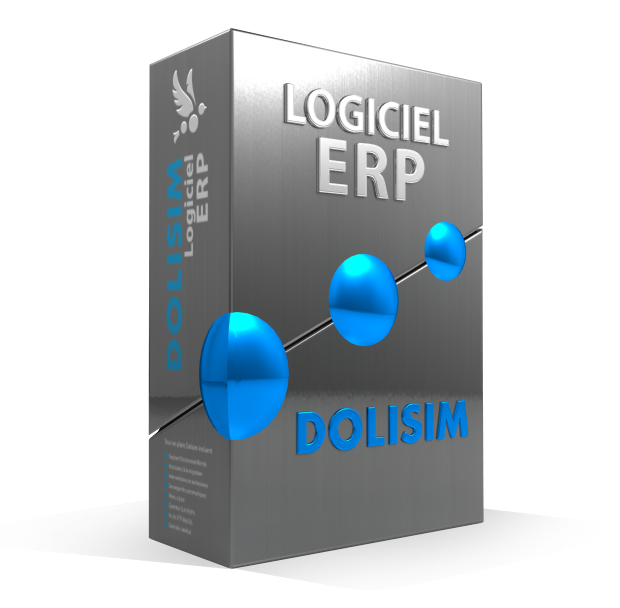
Contrairement aux autres logiciels dans le cloud, avec Dolisim vous deviendrez réellement propriétaire du logiciel. C’est-à-dire que vous pouvez à tout moment quitter leur service, tout en conservant le logiciel pleinement fonctionnel et vos données. Simafri (le prestataire qui commercialise Dolisim) est très engagé dans le développement des logiciels libres.
L’offre Dolisim propose un des meilleurs logiciels ERP gratuits qui existe sur le marché (Dolibarr), et ce depuis 2002, avec un support fonctionnel et des techniciens qui peuvent à tout moment intervenir pour vous aider, tout en vous laissant la possibilité de quitter leurs services AVEC votre logiciel ERP. Question qualité de logiciel, fonctionnalité, accompagnement et liberté, on ne fait tout simplement pas mieux.
Fonctionnalités
Dolisim vous offre toutes les fonctionnalités d’un ERP complet :
- Logiciel de Facturation
- Logiciel CRM
- Logiciel Gestion de stock
- Logiciel Gestion de projet
- Logiciel de Comptabilité
- Logiciel de Gestion de production
- Logiciel de Gestion locative
- Ainsi que toutes les autres fonctionnalités incluses dans Dolibarr
De plus, Dolisim vous donne accès à une équipe de développeurs spécialisés Dolibarr qui pourront sans aucune difficulté personnaliser votre logiciel, voire même développer des modules 100% sur-mesures.
Les plus
- Un logiciel très complet qui fait ses preuves depuis 2002 et qui compte aujourd’hui plus de 3 millions d’utilisateurs dans le monde
- Pas de limite dans le nombre d’utilisateurs, tous les plans Dolisim sont à utilisateurs illimités !
- Logiciel 100% open source dont vous devenez le propriétaire et que vous pouvez conserver même si vous quittez les services Dolisim
- Une équipe technique au top qui réagit rapidement et qui peut vraiment tout faire
- Logiciel responsive (qui peut être utilisé sur PC, tablette et smartphone)
- Possibilité de lier Dolisim avec votre site Internet (voir les prix d’un site Internet vitrine)
Les moins
- La seule chose que je puisse trouver à dire concerne le design, il est sobre et austère, mais bon il reste fonctionnel et responsive (fonctionne sur mobile)…
- Convient avant tout aux TPE / PME
Mes recommandations
- Vous êtes une TPE / PME ? Foncez, vous ne pouvez pas vous tromper avec ce logiciel
- Quand vous aurez besoin de développements personnalisés, faites marcher la concurrence, étant un logiciel open source dont vous possédez le code source, vous pouvez faire appel à n’importe quel informaticien qui maîtrise le PHP pour faire vos travaux, c’est beau la liberté hein :)
- Si vous voulez Dolibarr mais que vous n’êtes pas du tout informaticien, vous pouvez souscrire juste un mois chez Dolisim pour qu’ils vous installent et paramètrent tout, puis vous pouvez quitter en conservant votre logiciel pleinement fonctionnel…
- Si vous cherchez un ERP qui pourra vous servir toute votre vie, c’est la meilleure option car vous pouvez le faire évoluer comme bon vous semble.
Openflex, l’un des meilleurs ERP
Openflex est pour moi l’un des meilleurs candidats pour être en tête de ce top des ERP. Je ne m’attendais vraiment pas à trouver un ERP aussi simple à utiliser. Pourtant, Openflex n’est sur le marché que depuis 2017, même s’il a été développé à partir d’un framework existant depuis 2002. Il est donc assez récent mais je pense que c’est là que réside le secret de son succès. Il a su prendre en compte les besoins, les remarques et les critiques des utilisateurs d’ERP de ces 20 dernières années pour créer au final quelque chose d’efficace, de fiable et surtout, qui sait s’adapter à son environnement (contexte social, économique, juridique).

- Date de sortie : 2017 (framework depuis 2002)
- Dernière version : 4.1.3
- Développé sous : PHP
- Prise en main : Très facile
- Offre commerciale : Oui. Achat par module sans abonnement
- Mises à jour à vie incluses
- Application mobile : Oui
Les fonctionnalités majeures d’Openflex
- Gestion comptable et financière
- Gestion des ventes et de la relation client (CRM)
- Gestion des achats et logiciel des stocks
- Gestion de la paye et des ressources humaines (HRM)
- Gestion de points de vente (POS)
- Gestion de projet
- Développement vertical (station d’essence, hôtel, association, billetterie,…)
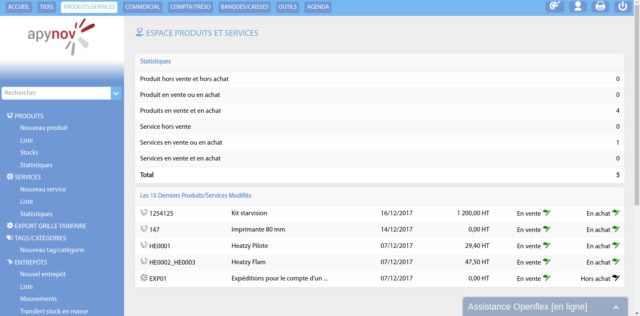
Les plus
- Ergonomie très bien étudiée. L’espace de travail est agréable et la prise en main très facile.
- Accès possible à Openflex même si le débit de la connexion internet est très faible.
- Il suffit d’acheter le module une fois et vous pouvez l’utiliser à vie avec support et mise à jour offert.
- Support disponible et très actif, même pour la version gratuite !
- Haut niveau de sécurité pour les données.
- Les modules sont développés dans une approche verticale.
- Disponible entièrement dans le Cloud. Tout ce dont vous avez besoin, c’est d’un navigateur web, que ce soit celui de votre PC, de votre tablette ou de votre smartphone.
Les moins
- Il n’y a encore que 25 modules disponibles à la vente. Cependant, ces modules seront suffisants pour 95% des sociétés.
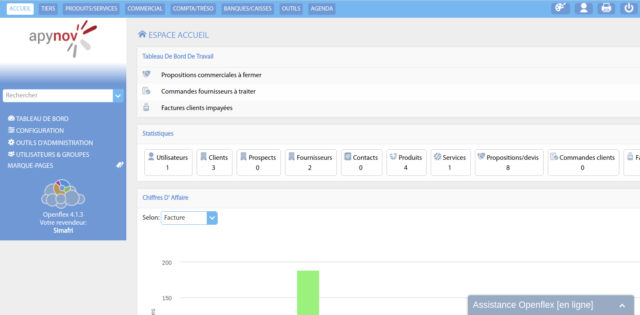
Mes recommandations
- Si Openflex vous tente, commencez par le maîtriser dès maintenant. Ainsi, votre entreprise pourra évoluer avec votre ERP.
- N’hésitez surtout pas à les contacter aussi pour le sur-mesure. La possibilité de pouvoir payer en monnaie local ouvre plus de perspectives aux entrepreneurs. Openflex est capable de créer des fonctionnalités et des modules en fonction de vos besoins spécifiques.
Bien que fonctionnant dans le Cloud, vous n’aurez pas à payer d’abonnement pour utiliser Openflex ! Vous aurez juste à acheter une fois pour toute les modules dont vous avez besoin (leurs futures mises à jour sont gratuites).
Rendez-vous sur le site Internet d’Openflex : https://openflex.cloud/fr/
iDempire
iDempiere est un ERP gratuit issu d’Adempiere auquel à été ajouté la technologie OSGi. Pour ma part, c’est l’un des meilleurs ERP Open Source gratuits que j’ai pu tester ces dernières semaines. En plus, il est incroyablement complet.
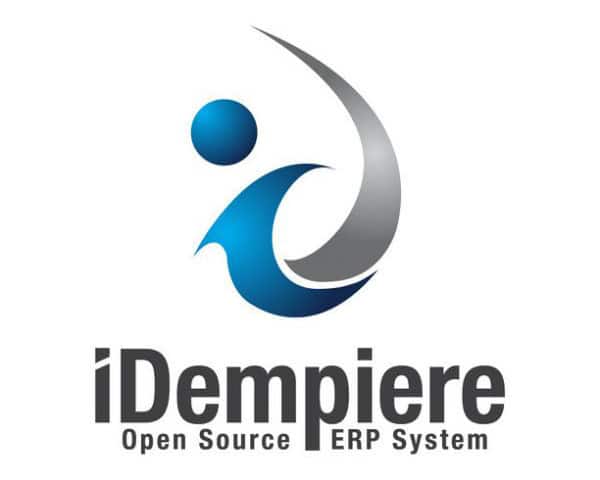
- Date de sortie : 2012
- Dernière version : 5.1
- Développé sous : Java
- Installation sur site : Oui
- Prise en main : Facile
- Offre commerciale : Non
- Application mobile : Oui
Les fonctionnalités majeures d’iDempiere
- Comptabilité & finance
- Gestion Commerciale (CRM)
- Gestion de la chaîne logistique (SCM) : approvisionnement, stock, fabrication, commande livraison
- Gestion des ressources humaines (HRM)
- Outil d’aide à la prise de décision (KPI)
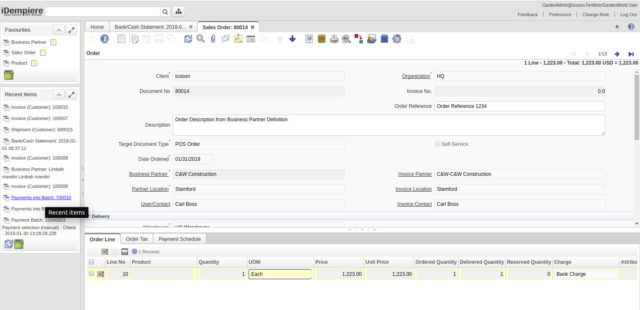
Les plus
- Les codes sources de cet ERP gratuit sont entièrement gratuits.
- La version démo permet de voir très clairement ce dont est capable iDempiere.
- Bonne ergonomie. Environnement simple et agréable.
- Une communauté en forte progression et très active surtout en matière de support.
- Les mises à jour sont quotidiennes.
Les moins
- Une prise en main qui prend un peu de temps pour ceux qui n’ont jamais utilisé d’ERP gratuit de leur vie. Cela dit, une fois que vous avez compris comment cela fonctionne, il n’y a rien à en redire.
- Les langues embarquées sont limitées. Il n’y a que l’anglais, l’espagnol et l’allemand. Pour plus d’options, il faut installer le pack de langue manuellement.
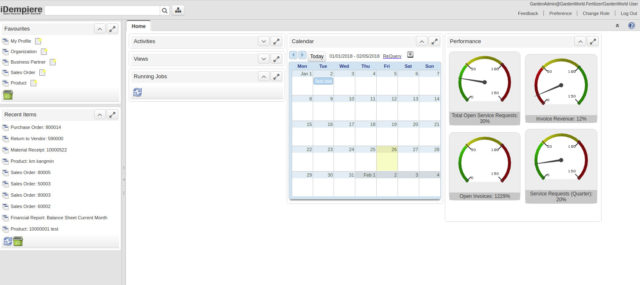
Mes recommandations
- Pour l’implémentation de l’ERP gratuit iDempiere, il est fortement recommandé d’engager un consultant ou une entreprise spécialisée pour le faire.
- Vous pouvez tester iDempiere ici.
- Et pour le télécharger cet ERP gratuit, c’est ici.
Xtuple
Xtuple est l’un des ERP gratuits en vogue du moment bien qu’il existe depuis un certain temps. Il a su tirer profit de ses expériences passées pour s’adapter aux besoins de ses utilisateurs. Au final, cela a donné un produit très flexible, personnalisable et qui suit facilement l’ensemble du workflow mis en place au sein d’une entreprise ou d’un organisme quelconque.
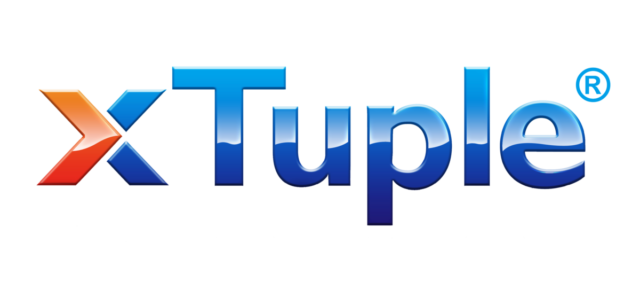
- Date de sortie : 2001
- Dernière version de l’ERP gratuit : 4.11.2
- Développé sous : C++
- Installation sur site : Oui
- Prise en main : Facile
- Offre commerciale : Oui. Abonnement allant de 45$ à 150$ par mois à partir de 5 utilisateurs.
- Application mobile : Oui
Les fonctionnalités majeures d’Xtuple
- Gestion comptable au grand complet
- Gestion de la relation client (CRM)
- API
- Gestion de la chaîne logistique (SCM) : approvisionnement, stock, fabrication, commande livraison
- Gestion des l’e-Commerce
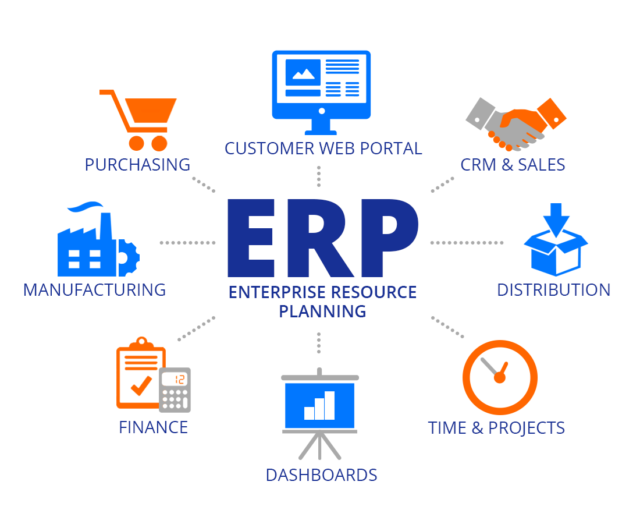
Les plus
- Xtuple PostBooks est un ERP accessible gratuitement s’il n’y a pas plus de 4 utilisateurs. Cela dit, avec une licence commerciale, l’utilisateur peut bénéficier de plus de fonctions.
- Un logiciel ERP très complet, même pour la version gratuite.
- La communauté qui travaille ou qui contribue dans le projet Xtuple PostBooks est très active. Elle constitue un support indéniable pour l’ERP gratuit.
- Les langues embarquées sont nombreuses.
- Xtuple couvre un large champ d’activité. Il peut servir à une entreprise de petite structure autant qu’à un organisme à but non lucratif ou gouvernemental.
Les moins
- Il n’y a pas de démo en ligne. Il faut télécharger Xtuple, l’installer sur son ordinateur ou le serveur interne avant de l’essayer.
- Pour ceux qui préfèrent installer le logiciel ERP gratuit au lieu d’utiliser la version cloud, il est préférable d’avoir un expert ou un support à portée de main.
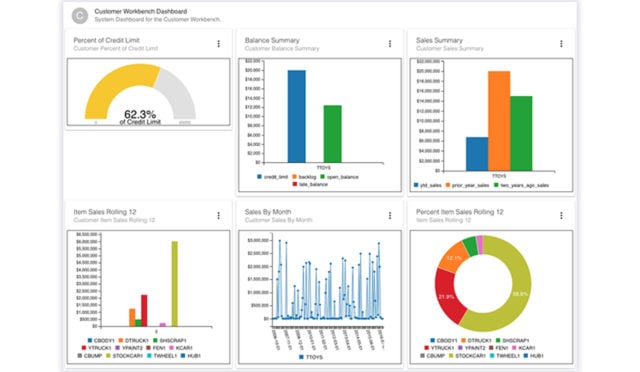
Mes recommandations
- Évaluez bien vos besoins parce que jusqu’à 4 utilisateurs, Xtuple est un ERP gratuit.
La page des tarifs est vraiment sympathique. Cela permet de bien calculer ce dont l’entreprise a vraiment besoin. - Vous pouvez tester Xtuple ici.
- Et pour le télécharger, c’est ici.
ERPnext, l’ERP gratuit Next Génération
ERPnext est un logiciel de gestion open source incroyablement complet qui a pris de la notoriété depuis quelques années. Il n’y a pas de licence à acheter, mais pour l’hébergement et le support, il faut passer par un abonnement annuel.
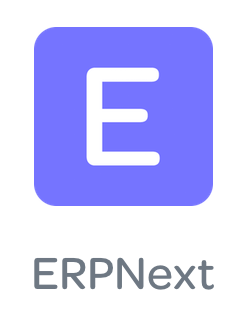
- Date de sortie de cet ERP gratuit : 2008
- Dernière version : 10.0.7
- Développé sous : Python et Javascript
- Installation sur site : Oui
- Prise en main : Facile
- Offre commerciale : Oui. Les prix varient en fonction des nombres d’utilisateurs allant de 299$ à 10 000$ par an.
- Application mobile : Oui
Les fonctionnalités majeures d’ERPnext
- Des modules verticaux
- Gestion des points de vente
- Gestion de la relation client (CRM)
- Gestion de la chaîne logistique (SCM) : approvisionnement, stock, fabrication, commande livraisons
- Gestion de projet
- Gestion des ressources humaines (HRM)
Les plus
- Un ERP gratuit très complet.
- Un design agréable et épuré, du moins, sur la version d’essai.
- Le coût de l’abonnement est intéressant à partir de 4 utilisateurs (environ 75 $ / utilisateur) par rapport aux autres ERP dans ce classement.
- Très facile à mettre à jour.
- S’adapte à différentes structures grâce à sa politique de verticalité allant du commerce de détail, en passant par les organismes de santé, les ONG, les écoles, les agriculteurs…
- Actuellement, il est géré par une fondation et non une entreprise commerciale. Il y a donc une volonté des éditeurs de maintenir l’application en Open Source.
Les moins
- Honnêtement, j’ai eu du mal à en trouver vu que j’ai surtout regardé du côté de la version d’essai. Mais en grappillant un peu sur les remarques les plus répétitives, faites par les autres utilisateurs, il semblerait que dans sa version actuelle, ERPnext convient mieux aux PME/PMI et aux entrepreneurs et non à de grosses structures avec de larges ramifications.
- Le demo de l’ERP gratuit n’est disponible que pendant 30 jours et beaucoup de fonctions ont été désactivées.
Mes recommandations
- Il semblerait que l’ERP gratuit EPRnext soit très apprécié surtout dans les pays anglophones comme les Émirats arabes unis, les États-Unis, l’Australie ou encore le Canada. Si vous voulez vous développer dans ces régions, il est préférable de vous familiariser avec cet outil dès maintenant.
- En allant sur la page démo d’ERPnext, on va vous demander d’abord de choisir une formule d’abonnement. Ne vous focalisez pas sur les prix, concentrez-vous plutôt sur le nombre d’utilisateurs.
- Plus vous avez des utilisateurs, plus ERPnext vous reviendra moins cher. Cela dit, comme ERPnext est plus adapté pour les petites et moyennes entreprises, je ne sais pas trop si l’économie réalisée est bien visible.
- Vous pouvez tester ERPnext ici.
- Et pour le télécharger, c’est ici.
WebERP
WebERP est l’un des premiers ERP gratuits à avoir adopté le cloud computing depuis son lancement en 2003. Il est clair que c’est une application gratuite qui sait prendre de l’avance sur ses concurrents. En 15 ans d’existence, il a su séduire des millions d’utilisateurs à travers le monde par son côté pratique et facile à utiliser.

- Date de sortie : 2003
- Dernière version : 4.14.1
- Développé sous : PHP
- Installation sur site : Oui
- Prise en main de l’ERP gratuit : Très facile
- Offre commerciale : Non
- Application mobile : Non. Mais il est possible d’ajouter quelques lignes de codes pour permettre une meilleure vue sur une tablette ou un smartphone (design responsive).
Les fonctionnalités majeures de WebERP
- Gestion des ventes et commandes
- Gestion des entrepôts et des stocks
- Gestion des factures
- Gestion des achats
- Gestion des fournisseurs
- Traitement comptable
- Gestion de la processus de fabrication
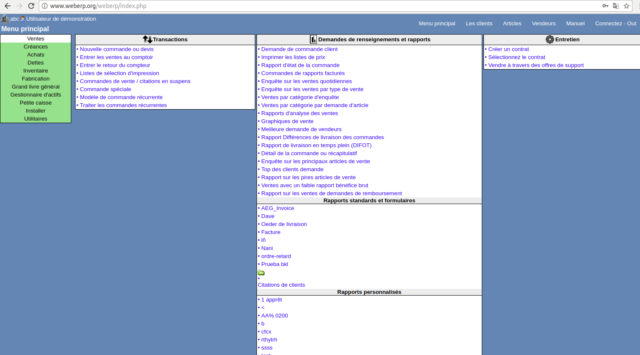
Les plus
- C’est un ERP gratuit qui consomme très peu de connexion internet.
- Très rapide en temps de chargement.
- Par défaut, la démo est en anglais, mais il est disponible en une trentaine de langue. Pour le changer, il suffit de modifier le profil utilisateur. Il est même possible de modifier la langue pour chaque utilisateur qui utilise le programme gratuit dans une même entreprise.
- La version de l’ERP gratuit à télécharger est très légère, à peine 30 Mo.
- Etant donné qu’il a été développé sous PHP, les codes sont assez faciles à modifier. Même si vous ne vous y connaissez pas, vous n’aurez aucun mal à trouver un développeur.
- Données hautement sécurisées surtout en ce qui concerne l’accès des utilisateurs.
Les moins
- L’interface de cet ERP gratuit est vraiment trop simple. Mais cela se comprend vu l’objectif initial du projet qui est de fournir un programme qui ne consomme pas de bande passante et qui se charge facilement.
- Je crois que j’aurais mis ce programme en premier s’il y avait dedans des modules pour la gestion de la clientèle et du personnel. Cela dit, vous pouvez toujours y intégrer des modules du même genre développés par d’autres éditeurs. Pas de panique, il y en a un certain nombre qui sont également gratuits et développés sous PHP pour une meilleure intégration.
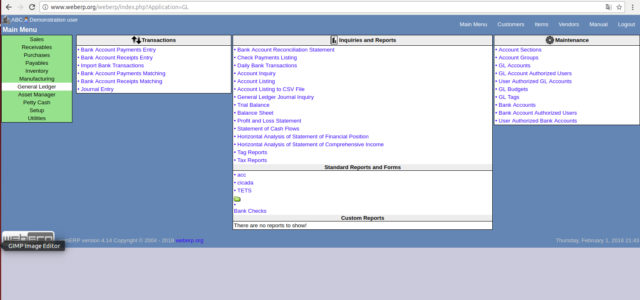
Mes recommandations
- Si vous faites du commerce de gros ou de grosses distributions, WebERP est un ERP gratuit parfait pour vous. Il est également adapté au commerce de détail, surtout pour les entreprises qui disposent de nombreux points de vente.
- Il convient plus aux petites et moyennes entreprises, même si WebERP est un ERP gratuit suffisamment flexible pour intégrer une structure plus grande.
- Vous pouvez tester WebERP ici.
- Et pour le télécharger, c’est ici.
EasyERP, un bon départ pour les débutants
EasyERP est un progiciel de gestion d’entreprise gratuit et complet. Récemment arrivé sur le marché, cet ERP gratuit a déjà réussi à séduire plusieurs milliers d’utilisateurs à travers le monde grâce à sa flexibilité surtout au niveau de la personnalisation. Pour ceux à la recherche de leur premier ERP gratuit, c’est un excellent choix.

- Date de sortie : 2014
- Dernière version : 1.0
- Développé sous : Node.js et MongoDB
- Installation sur site : Oui
- Prise en main : Facile
- Offre commerciale : Oui. Pour la version Software as a Service (SaaS) : 75 $ / utilisateur / mois. Le support demande un abonnement à part 12 $ / utilisateur / mois.
- Application mobile : Oui
Les fonctionnalités majeures d’EasyERP
- Gestion des points de vente
- Gestion de la relation client (CRM)
- Gestion de la chaîne logistique (SCM) : approvisionnement, stock, fabrication, commande livraisons
- Gestion de projet
- Gestion des ressources humaines (HRM)
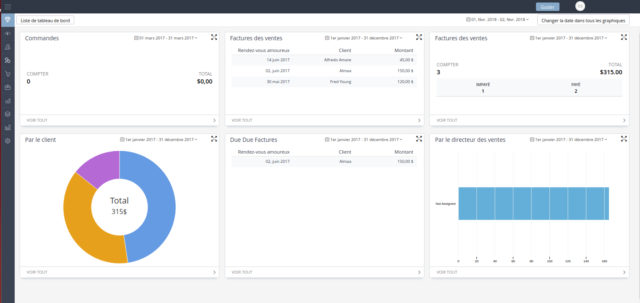
Les plus
- L’interface et ergonomie de cet ERP gratuit sont très agréables.
- Très facile à personnaliser. D’ailleurs, il est possible de commander des modules sur mesure auprès de l’éditeur.
- Pour l’instant, EasyERP n’est pas saturé de modules. Il est donc parfait pour ceux qui utilisent un ERP pour la première fois, surtout les petites structures. Ainsi, ils verront leurs entreprises évoluer avec leur ERP gratuit.
- La version payante est surtout réservée aux personnes et entreprises qui ont besoin de support rapproché ou de personnaliser leurs modules. Mais même ceux qui utilisent la version gratuite trouveront sur le site web une page de support très utile.
Les moins
- EasyERP est un ERP gratuit encore très jeune. Il n’est donc pas aussi complet que les mastodontes qui existent depuis des années. Cela dit, c’est un moins relatif puisque dans l’état où il est actuellement, il fait déjà tout ce dont on attend d’un ERP.
- Dans certains pays, les développeurs spécialisés en Node.js et en MongoDB ne courent pas encore les rues bien que ce soit des langages de programmation basés sous C, C++ et JavaScript.
- Les pays pris en charge sont encore limités. C’est plus en Europe, en Amérique et en Australie.
- Cet ERP gratuit n’est pas très pratique pour une connexion internet à faible débit.
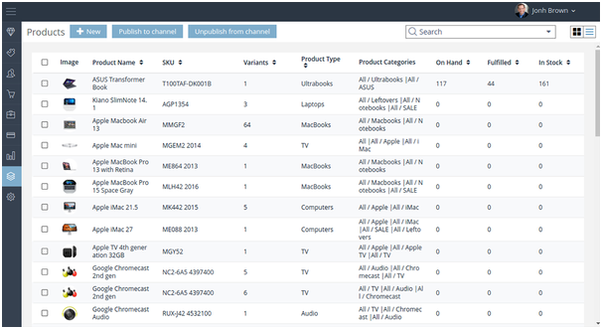
Mes recommandations
- Il est préférable d’avoir une bonne connexion internet. Une belle interface signifie le plus souvent un temps de chargement un peu plus long, même si les langages de développement permettent d’avoir quelque chose de rapide.
- Je reconnais qu’EasyERP est plutôt jeune vu qu’il n’est arrivé sur le marché qu’en 2013. Mais il semble tirer parti des erreurs de parcours des autres ERP gratuits beaucoup plus anciens… Cela lui a permis de s’imposer rapidement et en peu de temps. C’est vraiment un ERP gratuit à suivre de près.
- Évaluez bien les nombreux d’utilisateurs surtout pour la version Software as a service (SaaS). Plus il y a d’utilisateurs et plus le prix diminue.
- Vous pouvez tester EasyERP ici.
- Et pour le télécharger, c’est ici.
Dolibarr, un ERP gratuit valeur sure
Dolibarr est l’un des ERP gratuits les plus utilisés au monde. Avec ce progiciel, tout est vraiment à portée de main. Le principal avantage de Dolibarr est que la prise en main est vraiment facile. Même si vous n’avez jamais utilisé d’ERP, dès la première prise en main, vous savez ce que vous devez faire.
- Date de sortie : septembre 2003
- Dernière version : 6.0.4
- ERP gratuit développé sous : PHP et MySQL
- Installation sur site : Oui
- Prise en main : Très facile
- Offre commerciale : Oui. Il faut prévoir 9 €/mois/utilisateur pour l’offre Basique et 30 €/mois + 12 €/mois/utilisateur pour l’offre Premium.
- Application mobile : Oui
Les fonctionnalités majeures de Dolibarr
- Gestion de la relation client (CRM) et vente
- Gestion comptable
- Gestion de projet
- Gestion des commandes et des stocks
- Gestion des ressources humaines (HRM)
- Gestion de l’e-Commerce
Les plus
- Une prise en main très facile.
- L’ergonomie de cet ERP gratuit est agréable surtout avec tous les modules à essayer contenus dans la barre des menus en haut.
- Disponible en une quarantaine de langues.
- C’est un ERP gratuit qui s’adapte à différents types de structures allant de la grande distribution, en passant par l’administration publique jusqu’aux organisations à but non lucratif.
- Peu importe la version installée, une fois mise à jour, vous avez droit à la dernière version.
- Pour la version gratuite, il y existe une communauté très active.
Les moins
- Bien que Dolibarr dispose d’une licence Open Source, pour bénéficier d’une version stable et d’un bon support, l’option payante est beaucoup plus intéressante. Vous pouvez notamment voir l’offre Dolisim à ce sujet.
- De nombreux modules intéressants sont malheureusement payants. Ils sont disponibles sur son site de vente Dolistore.
- Pour un ERP gratuit d’une si grande notoriété, ce serait bien s’il pouvait aussi être catégorisé parmi les SCM. Mais ce n’est pas encore le cas.
Mes recommandations
Apache ofbiz
Apache Ofbiz est parfait pour ceux qui rêvent de liberté. C’est un ERP entièrement gratuit et tout peut être personnalisé.
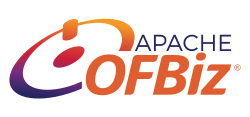
- Date de sortie : 2010
- Dernière version : 16.11.04
- Développé sous : Java
- Installation sur site : Oui
- Prise en main de cet ERP gratuit : Moyen
- Offre commerciale : Non
- Application mobile : Non
Les fonctionnalités majeures d’Apache Ofbiz
- Gestion de la comptabilité
- Gestion de la relation client et vent (CRM)
- Gestion de l’e-Commerce
- Gestion de la chaîne logistique (SCM) : approvisionnement, stock, fabrication, commande livraisons
- Gestion des ressources humaines (HRM)
- Gestion de points de vente (POS)
- Gestion de projet
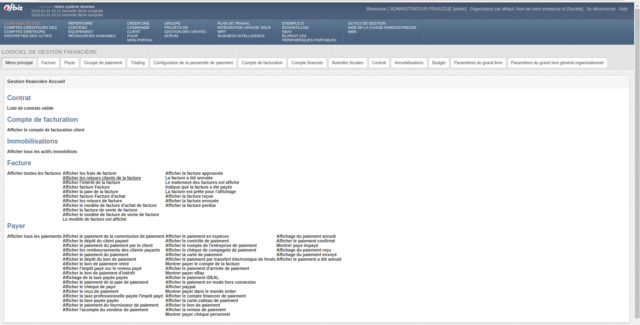
Les plus
- Une page démo de l’ERP gratuit vraiment complète.
- ERP gratuit qui peut convenir à n’importe quels types de structures ou d’entreprises, même les grandes multinationales.
- Il existe deux types de démo : une pour tout ce qui est visible pour les clients, notamment le site web ou la boutique en ligne et une autre (frontend) pour tout ce qui est interne à l’entreprise comme la comptabilité, le stock, les ressources humaines… dans le backend.
- Apache Ofbiz est géré par une fondation et épaulé par une communauté très active surtout dans leurs contributions et en matière de support.
Les moins
- Il faut un peu d’entraînement pour bien prendre en main le logiciel ERP. Vous aurez donc besoin d’avoir quelques heures devant vous pour bien le comprendre.
- Il est recommandé d’avoir une personne qui est habituée à Ofbiz durant la première utilisation.
- L’ergonomie fait défaut. Au premier regard, je me suis demandée par où regarder. Il y a tellement de modules dans cet ERP gratuit que j’étais un peu perdue.
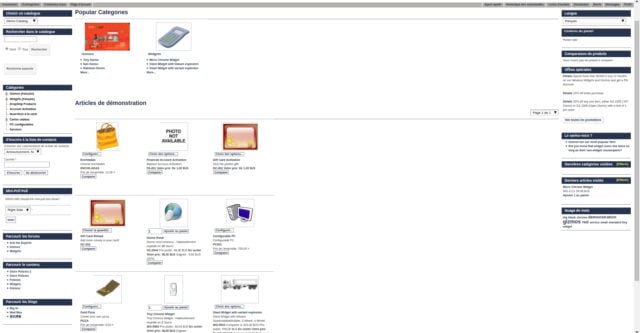
Mes recommandations
- Je ne sais pas si la langue qui s’affiche par défaut dans la démo de l’ERP gratuit est aléatoire ou non. Pour ma part, je suis tombée sur du chinois quand j’ai testé le Backend Management. Je vous conseille d’utiliser un navigateur web avec un traducteur automatique intégré comme Google Chrome par exemple pour faire le test.
- Si vous maîtrisez ce logiciel gratuit, il pourra combler tous tes besoins. Je ne pense pas que vous aurez besoin de changer d’ERP même si votre PME devient une énorme structure plus tard. Vous pouvez le faire évoluer parfaitement avec votre entreprise.
- Vous pouvez essayer Apache Ofbiz ici
- Et pour le télécharger, c’est ici
Odoo
Odoo est probablement l’ERP gratuit qui a évolué le plus vite parmi les logiciels dans sa catégorie. Il le doit au fait que tous ses codes jusqu’à sa 8ème version étaient entièrement libres d’accès. Aujourd’hui, Odoo fonctionne avec deux visages : une version commerciale et une version communauté, cette dernière étant de plus en plus limitée malheureusement…
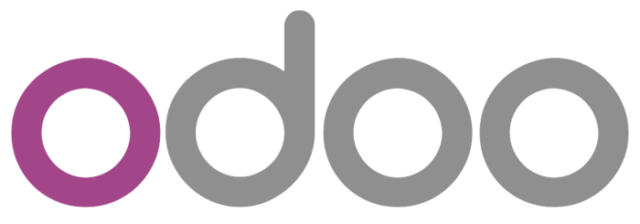
- Date de sortie : février 2005 sous le nom de Tiny ERP (Odoo depuis 2014)
- Dernière version : 11.0
- Developpé sous : Python, JavaScript, XML
- Installation sur site : Oui
- Prise en main : Moyen
- Offre commerciale : Oui. 8 $ par mois pour les plans en ligne et 8 $ par mois mais à payer par an.
- Application mobile : Oui
Les fonctionnalités majeures d’Odoo
- Gestion de l’e-Commerce
- Gestion comptable et financière
- Gestion des ventes et CRM
- Gestion des projets
- Gestion des resssources humaines (HRM)
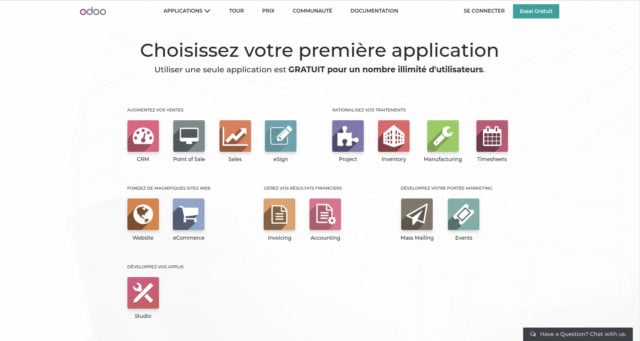
Les plus
- Un ERP gratuit très complet dans les modules qu’ils proposent grâce surtout à l’apport de la communauté. C’est la force d’Odoo.
- Facile à utiliser, mais demande un peu de temps pour s’y habituer.
- Interface épurée mais agréable.
- Facile à prendre en main grâce aux petites bulles qui montrent quoi faire au début.
- Pour les micro-entreprise, la version 8 est amplement suffisante.
- Comparez aux autres ERP gratuits, Odoo reste cependant très intéressant en termes de prix.
Les moins
- La documentation sur le site officiel est en anglais. Pour aller plus vite, utilisez un navigateur comme Google Chrome par exemple qui vous permet de traduire instantanément.
- La version communauté de cet ERP gratuit est trop restreinte. La plupart des modules intéressants sont surtout disponibles sur Odoo Entreprise, qui n’est pas un ERP gratuit.
- La prise en main qui demande un peu de temps. J’ai noté dans mes recherches que des millions de personnes utilisent Odoo. C’est vrai que grâce à ses modules et aux petites animations au tout début, c’est nettement plus clair. Sans cela, je sais que je me serai perdue facilement. Je pense que pour un entrepreneur qui travail seul avec un petit business, il faut bien réfléchir avant de l’utiliser surtout s’il veut l’installer sur son propre serveur.
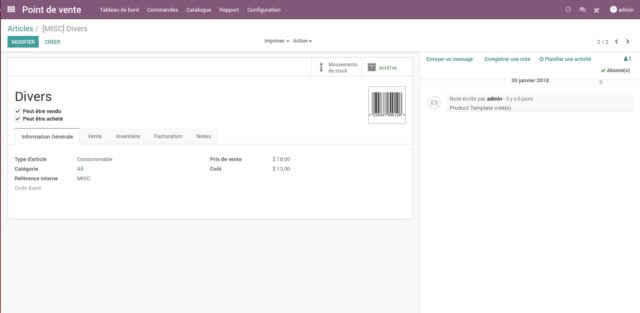
Mes recommandations
- Je vous conseille d’essayer d’abord la version Demo d’Odoo en ligne. Cela vous donnera un très bon aperçu sur ce qui vous attend surtout que vous pouvez accéder à 46 modules. Attention tout de même à ne pas vous laisser aller. Il s’agit d’une démo. La version d’essai n’est accessible que durant 15 jours pour les modules extras et toutes les 4 heures la base de donnée est réinitialisée.
- Il y a désormais une trop grande différence entre le Odoo-Community et le Odoo-Entreprise. Si c’est pour une utilisation sur du long terme surtout concernant les outils de gestion de base comme le CRM, la gestion des vente, la comptabilité et finance, la version commerciale est nettement recommandée pour une meilleure stabilité.
Openbravo
Openbravo est l’un des rares ERP gratuits dans ce classement qui a, dès le début, été développé dans un but commercial tout en restant un open source. Cela lui a permis d’avoir un environnement de développement très sain. Le logiciel est basé sur la licence publique Mozilla (MPL) dans le but de laisser un maximum de marge de manœuvre aux utilisateurs.
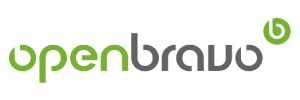
- Date de sortie : 2005 sous le nom de Tecnicia
- Dernière version de l’ERP gratuit : 3
- Développé sous : Java sur la base de Compiere
- Installation sur site : Oui
- Offre commerciale : Oui
- Prise en main : Facile
- Offre commerciale : Oui avec deux produits : Openbravo Commerce et Openbravo Cloud
- Application mobile : Oui (mais dans les offres commerciales).
Les fonctionnalités majeures d’Openbravo
- Des solutions verticales
- Gestion de la comptabilité
- Gestion de la relation client et vent (CRM)
- Gestion de l’e-Commerce
- Gestion de la chaîne logistique (SCM) : approvisionnement, stock, fabrication, commande livraisons
- Gestion des ressources humaines (HRM)
- Gestion de points de vente (POS)
- Gestion de projet
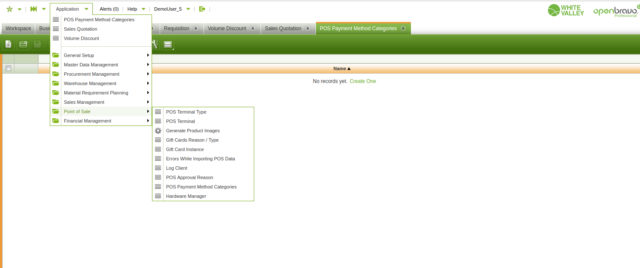
Les plus
- Le menu de cet ERP gratuit est bien géré. Tout est parfaitement bien rangé, bien catégorisé. Cela permet aussi aux entrepreneurs un peu étourdi de bien situer chaque branche de son activité.
- L’ergonomie du site aussi est très agréable.
- Idéal pour les ventes au détail. Mais la politique de verticalité d’Openbravo lui permet de proposer à des entreprises dans le domaine de l’agriculture, de l’habillement, du sport ou encore de la beauté par exemple d’avoir des ERP qui leur convient parfaitement.
- La possibilité d’intégrer d’autres modules sous la licence.
- Il s’adapte bien à son environnement socio-économique. Pour les Français par exemple, son POS a été mis à jour pour correspondre à la loi de finance 2018 de leur pays.
- La présence d’une communauté qui apporte un développement rapide au programme.
Les moins
- La version communautaire qui est gratuite est malheureusement trop limitée dans ses fonctionnalités.
- Le prix de l’abonnement est un peu élevé par rapport aux autres ERP de ce classement. En faisant un petit calcul, c’est la version Entreprise Cloud qui est la plus rentable à condition qu’il y ait plus d’un utilisateur. Cela revient à 156 $ / utilisateur / mois.
- Il faut obligatoirement remplir un formulaire pour accéder à la version démo.
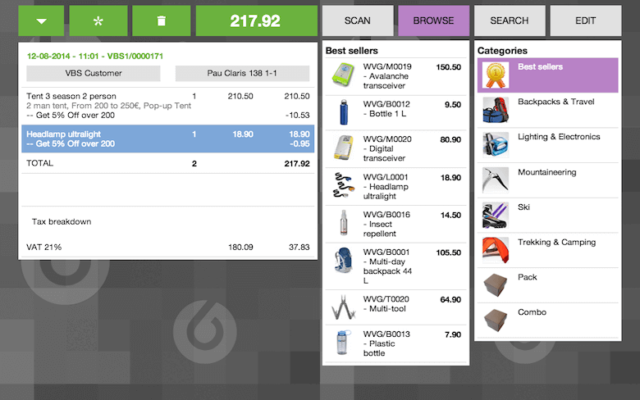
Mes recommandations
- Openbravo convient plus aux PMI et aux PME.
- Si vous n’y connaissez pas grand-chose en programmation, franchement, je vous le dis, regardez tout de même de près la version payante. J’ai vu très peu de remarques négatives de la part des utilisateurs, sauf peut-être au niveau des couleurs.
- Cela dit, la version payante n’est vraiment pas intéressant s’il y a moins d’une vingtaine d’utilisateurs au minimum.
- Vous pouvez essayer Openbravo ici.
- Et pour le télécharger, c’est ici.
Adempiere
ADempiere est une véritable légende en matière d’ERP gratuit surtout que sa création n’est pas passée inaperçue. Elle est née d’un conflit au sein de ceux qui participaient au développement de Compiere. A l’heure actuelle, ADempiere est un projet qui dépend énormément de sa communauté.
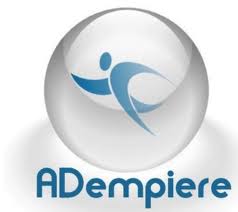
- Date de sortie : 2006
- Dernière version : 3.9.0
- Développé sous : Java
- Installation sur site : Oui
- Prise en main : Moyen
- Offre commerciale : Non
- Application mobile : Non
Les fonctionnalités majeures d’ADempiere
- Gestion de la comptabilité
- Gestion de projet
- Gestion de la relation client et vent (CRM)
- Gestion de l’e-Commerce
- Gestion de la chaîne logistique (SCM) : approvisionnement, stock, fabrication, commande livraisons
- Gestion des ressources humaines (HRM)
- Gestion de points de vente (POS)
- Gestion des migrations
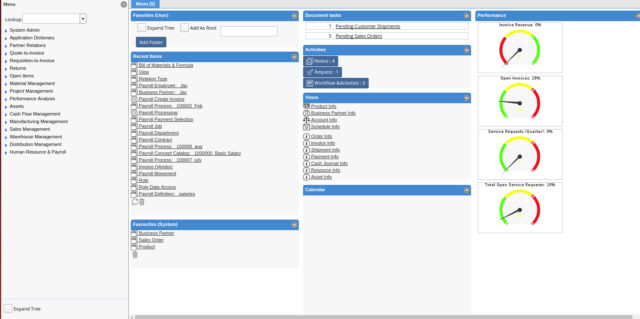
Les plus
- L’existence d’un conseil de contributeurs. Cela évite au projet de dériver et de rester dans sa ligne directrice.
- C’est un ERP gratuit assez flexible. Il convient à n’importe quelle structure, même à une grosse structure faisant par exemple plus de $ 500 millions de chiffre d’affaires.
Les moins
- Il faut vraiment prendre son temps pour la prise en main.
- Il n’y a qu’une dizaine de langues qui est pré-installée dans cet ERP gratuit. Pour le français par exemple, il va falloir télécharger le pack langage et l’installer manuellement.
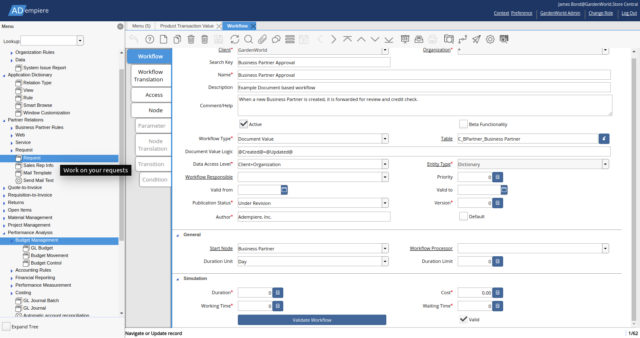
Mes recommandations
- Franchement, si c’est la toute première fois dans votre vie que vous utilisez un ERP gratuit et que vous cherchez quelque chose de simple, je ne sais pas si vous devez commencer par celui-là. Cela va vous prendre un peu de temps ou vous demander un peu d’aide pour le maîtriser, surtout au début. Cela dit, Adempiere bénéficie d’une communauté très active et a acquis une très bonne notoriété au cours de ces 12 dernières années.
- Vous pouvez tester ADempiere ici.
- Et pour le télécharger, c’est ici.
On en parle beaucoup… mais c’est quoi un ERP ?
Avant de faire ce top, j’étais surtout à la recherche de mon premier ERP. Je voulais quelque chose qui soit facile à utiliser, gratuit ou payant, pratique et fonctionnel. Si vous êtes dans le même cas que moi, ce top est fait pour vous. Cela dit, un ERP est comme n’importe quel outil. Dire qu’un ERP gratuit ou payant est mieux qu’un autre dépendra aussi de vos besoins, de vos moyens et de ce que vous voulez faire avec votre logiciel. Je reconnais tout de même qu’il y a vraiment de mauvais ERP : mal faits, mal programmés, trop difficiles à utiliser, pas opérationnels, trop chers… bref, inutiles!
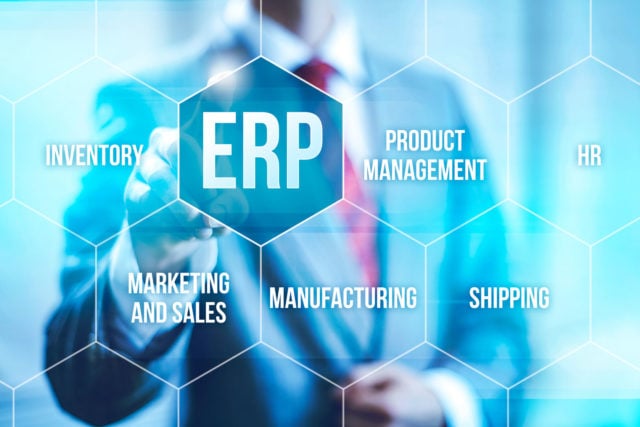
Le mot ERP est l’abréviation anglaise des termes Entreprise Ressource Planning. Une expression équivalente existe en français, Progiciel de Gestion Intégré ou PGI, mais apparemment, l’expression ne semble pas être très accrocheuse. Depuis une dizaine d’années, les nombres d’utilisateurs et d’éditeurs ont explosé. Pourtant, des programmes (l’équivalent d’un module actuellement) ont déjà été développés dans les années 60. Mais c’est à partir des années 90 que des ERP plus complets sont apparus sur le marché.
Avec l’évolution des langages informatiques, le fait qu’il y ait plus de développeurs ou de contributeurs et que les éditeurs disposent actuellement d’une certaine expérience, les ERP gratuits et payants ont finalement su trouver leurs place auprès d’un large public. La vulgarisation des ordinateurs, des appareils mobiles et de l’accès à internet ont également contribué à l’essor de l’ERP.
Il faut savoir qu’un ERP gratuit ou payant n’a pas vraiment de sens s’il ne permet pas un accès à distance et la création d’un réseau pour permettre aux informations de circuler. Actuellement, la tendance va aussi aux ERP Open Source, disposant d’une application mobile et ayant adopté une politique de verticalité (développé en fonction d’un métier bien spécifique).
Si un programme veut être considéré comme un ERP, il doit :
- permettre de récolter toutes les informations dont l’entreprise a besoin pour bien fonctionner ;
- être composé de plusieurs modules fabriqués par une même entité (communauté, personnes, entreprises, éditeur…) ;
- avoir au moins deux modules qui interagissent : c’est-à-dire que si vous touchez à l’un, cela doit changer les données dans l’autre module en même temps. Au final, il n’y aura qu’une seule base de données peu importe le module sur lequel les informations ont été saisies ou sur lequel elles seront consultées. Il est à souligner que dans un bon ERP, les modules doivent pouvoir être installés un à un pour permettre un maximum de liberté à son utilisateur ;
- permettre un suivi des activités en temps réel.
Points communs que partagent les ERP gratuits et payants
Il est vrai qu’un ERP gratuit est plus synonyme d’Open Source, même si ce n’est pas forcément le cas. Par exemple, il y a des entreprises éditrices d’ERP qui proposent gratuitement leurs produits jusqu’à un certain nombre d’utilisateurs. Mais en ce qui concerne les Open Source tout particulièrement, cela signifie qu’un utilisateur peut accéder aux codes sources, même si quelquefois, il faut d’abord acheter une licence. Il est ensuite libre de modifier les codes comme il l’entend pour rendre son ERP gratuit plus compatible avec son activité.
La plupart des ERP Open Source fonctionnent dans le Cloud. Les données ne sont donc pas stockées dans les locaux de l’utilisateur mais dans des serveurs externes. Il y accède via un navigateur et une connexion internet. C’est très pratique et économique parce qu’ainsi les risques de perdre des données, causés par une défaillance matérielle, sont limités. Utiliser le cloud computing facilite également la mise à jour de l’ERP. Elle pourra se faire automatiquement.
En ce qui concerne les mises à jour justement, elles peuvent aller très vite. C’est compréhensible vu que derrière un programme Open Source, il y a toujours une communauté qui apporte une précieuse contribution. C’est un facteur de développement rapide parce qu’il n’y a pas de limites aux nombres de contributeurs et que leurs apports sont le plus souvent gratuits.
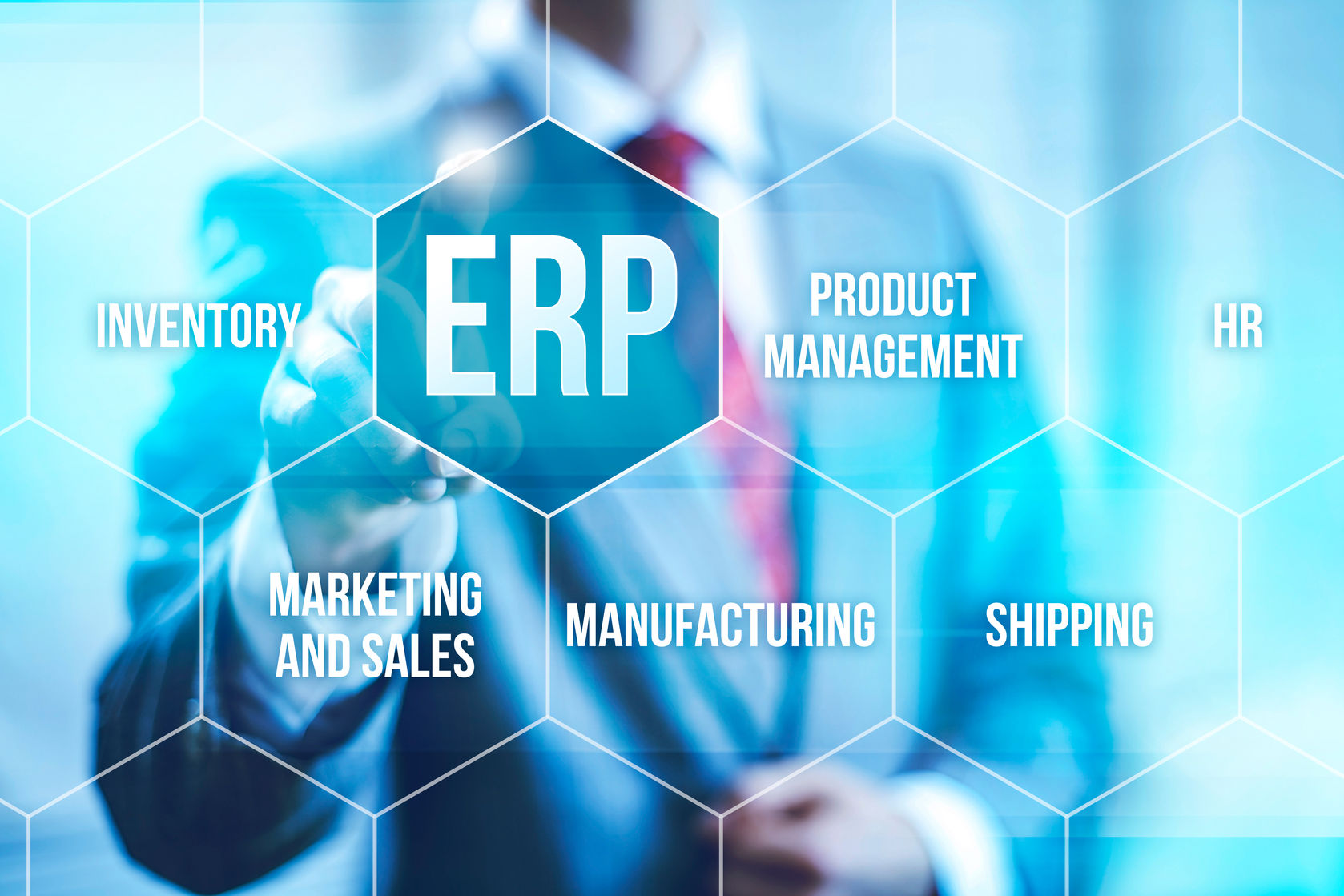
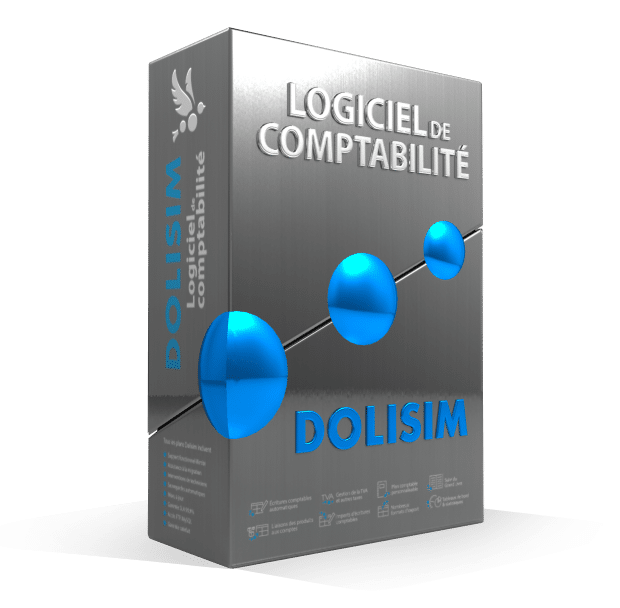
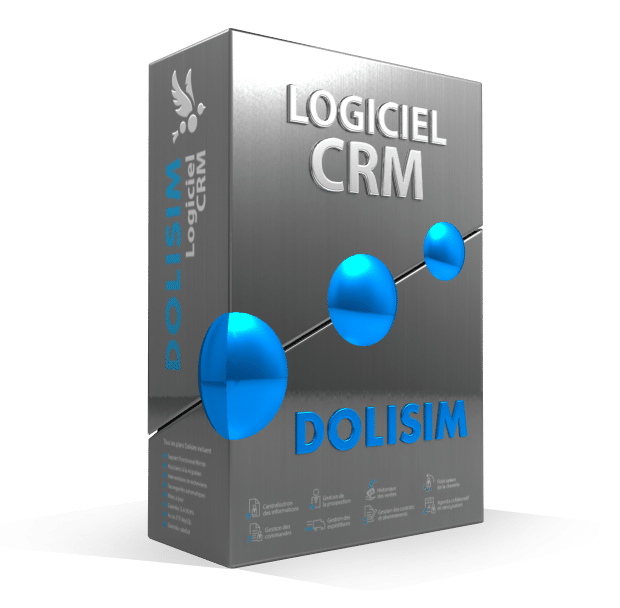
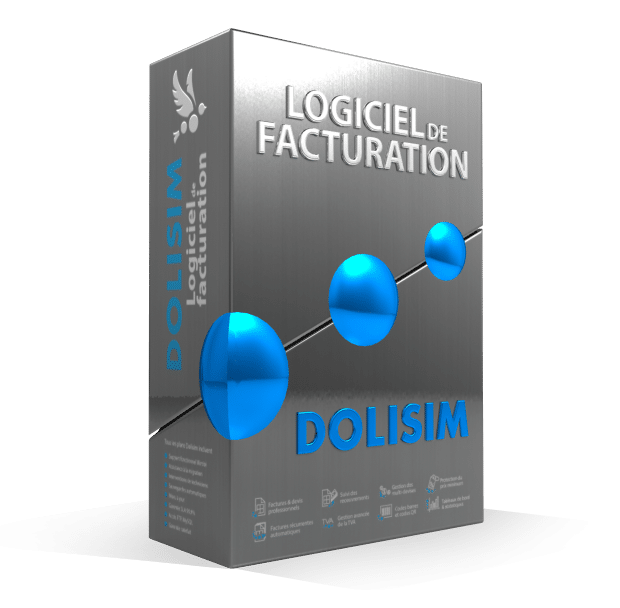


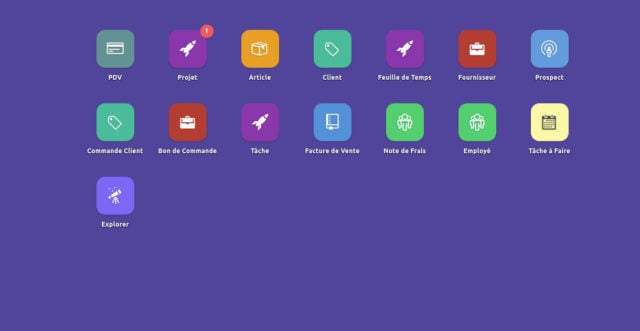
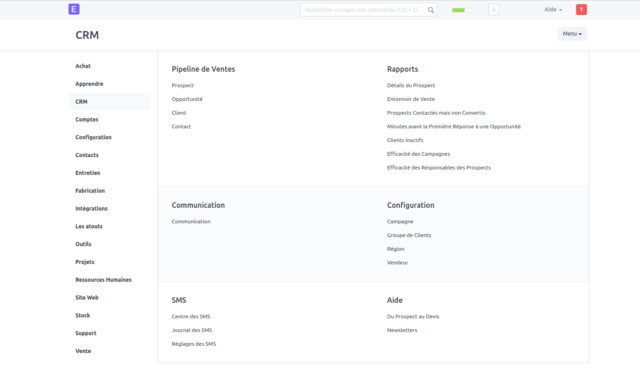

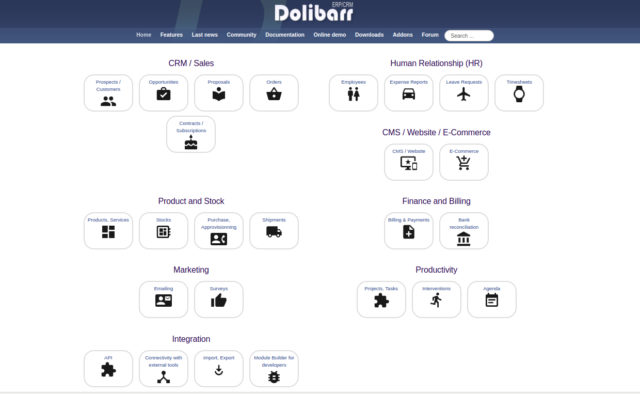
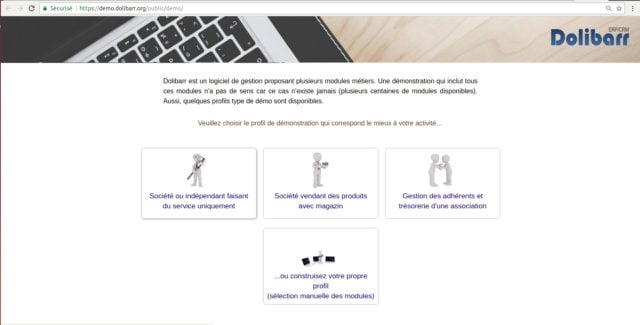
Merci de votre partage
Concernant Odoo, l’utilisation de modules tiers gratuits (ex: OCA) permet de combler l’écart entre l’édition Community et l’édition Entreprise :
https://odoo-community.org/
https://github.com/OCA/
Petit rectificatif : Ofbiz existe depuis 2001 (et non pas 2010).
J’avais étudié cet ERP en 2003-2004.
TOP! Futur entrepreneur à Madagascar, vous me sauvez la vie!
Bravo
un article clair, précis, qui permet de faire le choix approprié. une aide pour aider ma clientèle.
Merci pour cette analyse claire, je suis très intéressé par un ERP-CRM open source et surtout gratuit,
pour OpenBravo POS point de vente, est-il gratuit et suffisant pour par exemple un restaurant ou supérette…? merci d’avance.
Article vraiment complet et intéressant, qui m’a fait connaître certaines logiciels de gestion (ERP) que je ne connaissais pas. Le monde de l’open-source est vaste, avec ses propres modèles économiques qui peuvent être assez divers en fait (offre en SaaS, accès au support payant, aide au paramétrage, vente de modules complémentaires, proposition de développements spécifiques si nécessaire, etc). J’avais paramétré un CRM open-source chez un client en mode projet qui avait acheté un add-on développé par un programmeur russe, c’était tout un poème. ?